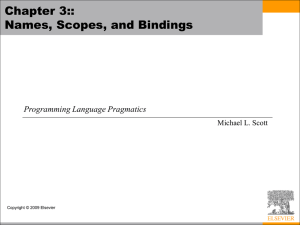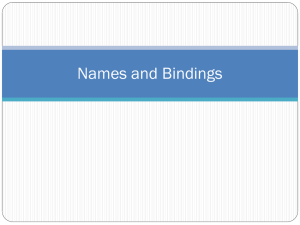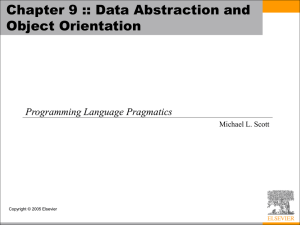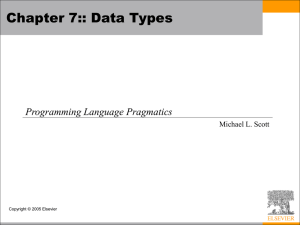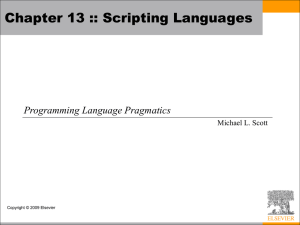Chapter 3
advertisement
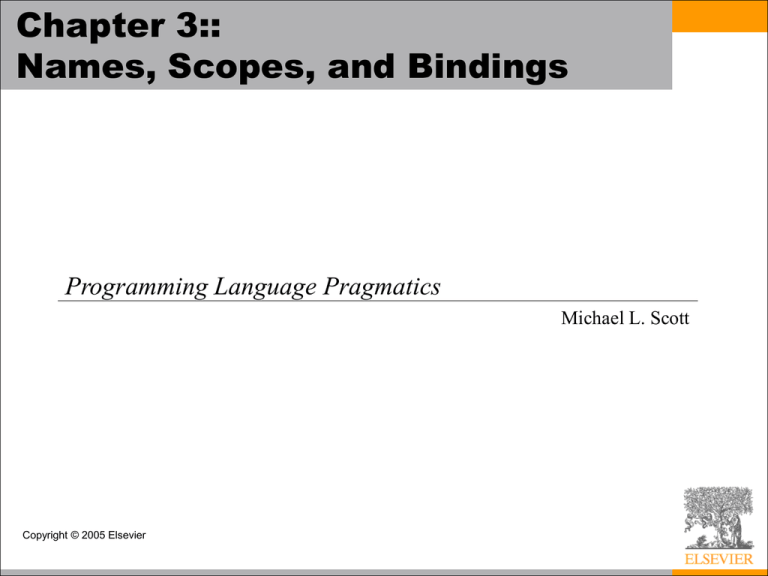
Chapter 3::
Names, Scopes, and Bindings
Programming Language Pragmatics
Michael L. Scott
Copyright © 2005 Elsevier
Name, Scope, and Binding
• A name is exactly what you think it is
– Most names are identifiers
– symbols (like '+') can also be names
• A binding is an association between two
things, such as a name and the thing it
names
• The scope of a binding is the part of the
program (textually)in which the binding is
active
Copyright © 2005 Elsevier
Binding
• Binding Time is the point at which a binding is
created or, more generally, the point at which
any implementation decision is made
– language design time
• program structure, possible type
– language implementation time
• I/O, arithmetic overflow, type equality (if unspecified in
manual)
Copyright © 2005 Elsevier
Binding
• Implementation decisions (continued ):
– program writing time
• algorithms, names
– compile time
• plan for data layout
– link time
• layout of whole program in memory
– load time
• choice of physical addresses
Copyright © 2005 Elsevier
Binding
• Implementation decisions (continued):
– run time
• value/variable bindings, sizes of strings
• subsumes
– program start-up time
– module entry time
– elaboration time (point a which a declaration is first
"seen")
– procedure entry time
– block entry time
– statement execution time
Copyright © 2005 Elsevier
Binding
• The terms STATIC and DYNAMIC are
generally used to refer to things bound
before run time and at run time, respectively
– “static” is a coarse term; so is "dynamic"
• IT IS DIFFICULT TO OVERSTATE THE
IMPORTANCE OF BINDING TIMES IN
PROGRAMMING LANGUAGES
Copyright © 2005 Elsevier
Binding
• In general, early binding times are associated
with greater efficiency
• Later binding times are associated with greater
flexibility
• Compiled languages tend to have early
binding times
• Interpreted languages tend to have later
binding times
• Today we talk about the binding of identifiers
to the variables they name
Copyright © 2005 Elsevier
Binding
• Scope Rules - control bindings
– Fundamental to all programming languages is the
ability to name data, i.e., to refer to data using
symbolic identifiers rather than addresses
– Not all data is named! For example, dynamic
storage in C or Pascal is referenced by pointers,
not names
Copyright © 2005 Elsevier
Lifetime and Storage Management
• Key events
–
–
–
–
–
–
–
creation of objects
creation of bindings
references to variables (which use bindings)
(temporary) deactivation of bindings
reactivation of bindings
destruction of bindings
destruction of objects
Copyright © 2005 Elsevier
Lifetime and Storage Management
• The period of time from creation to destruction is
called the LIFETIME of a binding
– If object outlives binding it's garbage
– If binding outlives object it's a dangling
reference
• The textual region of the program in which the
binding is active is its scope
• In addition to talking about the scope of a binding,
we sometimes use the word scope as a noun all by
itself, without an indirect object
Copyright © 2005 Elsevier
Lifetime and Storage Management
• Storage Allocation mechanisms
– Static
– Stack
– Heap
• Static allocation for
–
–
–
–
–
code
globals
static or own variables
explicit constants (including strings, sets, etc)
scalars may be stored in the instructions
Copyright © 2005 Elsevier
Lifetime and Storage Management
Copyright © 2005 Elsevier
Lifetime and Storage Management
• Central stack for
– parameters
– local variables
– temporaries
• Why a stack?
– allocate space for recursive routines
(not necessary in FORTRAN – no recursion)
– reuse space
(in all programming languages)
Copyright © 2005 Elsevier
Lifetime and Storage Management
• Contents of a stack frame (cf., Figure 3.2)
–
–
–
–
arguments and returns
local variables
temporaries
bookkeeping (saved registers, line number static
link, etc.)
• Local variables and arguments are assigned
fixed OFFSETS from the stack pointer or
frame pointer at compile time
Copyright © 2005 Elsevier
Lifetime and Storage Management
Copyright © 2005 Elsevier
Lifetime and Storage Management
• Maintenance of stack is responsibility of
calling sequence and subroutine prolog and
epilog
– space is saved by putting as much in the prolog
and epilog as possible
– time may be saved by
• putting stuff in the caller instead
or
• combining what's known in both places
(interprocedural optimization)
Copyright © 2005 Elsevier
Lifetime and Storage Management
• Heap for dynamic allocation
Copyright © 2005 Elsevier
Scope Rules
• A scope is a program section of maximal size in
which no bindings change, or at least in which
no re-declarations are permitted (see below)
• In most languages with subroutines, we OPEN a
new scope on subroutine entry:
– create bindings for new local variables,
– deactivate bindings for global variables that are redeclared (these variable are said to have a "hole" in
their scope)
– make references to variables
Copyright © 2005 Elsevier
Scope Rules
• On subroutine exit:
– destroy bindings for local variables
– reactivate bindings for global variables that were
deactivated
• Algol 68:
– ELABORATION = process of creating bindings
when entering a scope
• Ada (re-popularized the term elaboration):
– storage may be allocated, tasks started, even
exceptions propagated as a result of the
elaboration of declarations
Copyright © 2005 Elsevier
Scope Rules
• With STATIC (LEXICAL) SCOPE RULES, a
scope is defined in terms of the physical
(lexical) structure of the program
– The determination of scopes can be made by the
compiler
– All bindings for identifiers can be resolved by
examining the program
– Typically, we choose the most recent, active
binding made at compile time
– Most compiled languages, C and Pascal included,
employ static scope rules
Copyright © 2005 Elsevier
Scope Rules
• The classical example of static scope rules is
the most closely nested rule used in block
structured languages such as Algol 60 and
Pascal
– An identifier is known in the scope in which it is
declared and in each enclosed scope, unless it is
re-declared in an enclosed scope
– To resolve a reference to an identifier, we examine
the local scope and statically enclosing scopes
until a binding is found
Copyright © 2005 Elsevier
Scope Rules
• We will see classes - a relative of modules - later
on, when discussing abstraction and objectoriented languages
– These have even more sophisticated (static) scope
rules
• Euclid is an example of a language with
lexically-nested scopes in which all scopes are
closed
– rules were designed to avoid ALIASES, which
complicate optimization and correctness arguments
Copyright © 2005 Elsevier
Scope Rules
• Note that the bindings created in a
subroutine are destroyed at subroutine exit
– The modules of Modula, Ada, etc., give you
closed scopes without the limited lifetime
– Bindings to variables declared in a module are
inactive outside the module, not destroyed
– The same sort of effect can be achieved in
many languages with own (Algol term) or static
(C term) variables (see Figure 3.5)
Copyright © 2005 Elsevier
Scope Rules
• Access to non-local variables STATIC LINKS
– Each frame points to the frame of the (correct
instance of) the routine inside which it was
declared
– In the absence of formal subroutines, correct means
closest to the top of the stack
– You access a variable in a scope k levels out by
following k static links and then using the known
offset within the frame thus found
• More details in Chapter 8
Copyright © 2005 Elsevier
Scope Rules
Copyright © 2005 Elsevier
Scope Rules
• The key idea in static scope rules is that
bindings are defined by the physical (lexical)
structure of the program.
• With dynamic scope rules, bindings depend
on the current state of program execution
– They cannot always be resolved by examining the
program because they are dependent on calling
sequences
– To resolve a reference, we use the most recent,
active binding made at run time
Copyright © 2005 Elsevier
Scope Rules
• Dynamic scope rules are usually
encountered in interpreted languages
– early LISP dialects assumed dynamic scope
rules.
• Such languages do not normally have
type checking at compile time because
type determination isn't always possible
when dynamic scope rules are in effect
Copyright © 2005 Elsevier
Scope Rules
Example: Static vs. Dynamic
program scopes (input, output );
var a : integer;
procedure first;
begin a := 1; end;
procedure second;
var a : integer;
begin first; end;
begin
a := 2; second; write(a);
end.
Copyright © 2005 Elsevier
Scope Rules
Example: Static vs. Dynamic
• If static scope rules are in effect (as would be
the case in Pascal), the program prints a 1
• If dynamic scope rules are in effect, the
program prints a 2
• Why the difference? At issue is whether the
assignment to the variable a in procedure first
changes the variable a declared in the main
program or the variable a declared in
procedure second
Copyright © 2005 Elsevier
Scope Rules
Example: Static vs. Dynamic
• Static scope rules require that the reference
resolve to the most recent, compile-time binding,
namely the global variable a
• Dynamic scope rules, on the other hand, require
that we choose the most recent, active binding at
run time
– Perhaps the most common use of dynamic scope rules
is to provide implicit parameters to subroutines
– This is generally considered bad programming
practice nowadays
• Alternative mechanisms exist
Copyright © 2005 Elsevier
– static variables that can be modified by auxiliary routines
– default and optional parameters
Scope Rules
Example: Static vs. Dynamic
• At run time we create a binding for a when we
enter the main program.
• Then we create another binding for a when we
enter procedure second
– This is the most recent, active binding when
procedure first is executed
– Thus, we modify the variable local to procedure
second, not the global variable
– However, we write the global variable because the
variable a local to procedure second is no longer
active
Copyright © 2005 Elsevier
Binding of Referencing Environments
• Accessing variables with dynamic scope:
– (1) keep a stack (association list) of all active
variables
• When you need to find a variable, hunt down from
top of stack
• This is equivalent to searching the activation records
on the dynamic chain
Copyright © 2005 Elsevier
Binding of Referencing Environments
• Accessing variables with dynamic scope:
– (2) keep a central table with one slot for every
variable name
• If names cannot be created at run time, the table
layout (and the location of every slot) can be fixed at
compile time
• Otherwise, you'll need a hash function or something
to do lookup
• Every subroutine changes the table entries for its
locals at entry and exit.
Copyright © 2005 Elsevier
Binding of Referencing Environments
• (1) gives you slow access but fast calls
• (2) gives you slow calls but fast access
• In effect, variable lookup in a dynamicallyscoped language corresponds to symbol
table lookup in a statically-scoped language
• Because static scope rules tend to be more
complicated, however, the data structure
and lookup algorithm also have to be more
complicated
Copyright © 2005 Elsevier
Binding of Referencing Environments
• REFERENCING ENVIRONMENT of a
statement at run time is the set of active
bindings
• A referencing environment corresponds to a
collection of scopes that are examined (in
order) to find a binding
Copyright © 2005 Elsevier
Binding of Referencing Environments
• SCOPE RULES determine that collection
and its order
• BINDING RULES determine which
instance of a scope should be used to
resolve references when calling a procedure
that was passed as a parameter
– they govern the binding of referencing
environments to formal procedures
Copyright © 2005 Elsevier
Binding within a Scope
• Aliasing
– What are aliases good for? (consider uses of
FORTRAN equivalence)
• space saving - modern data allocation methods are
better
• multiple representations - unions are better
• linked data structures - legit
– Also, aliases arise in parameter passing as an
unfortunate side effect
• Euclid scope rules are designed to prevent this
Copyright © 2005 Elsevier
Binding within a Scope
• Overloading
– some overloading happens in almost all
languages
• integer + v. real +
• read and write in Pascal
• function return in Pascal
– some languages get into overloading in a big
way
• Ada (see Figure 3.18 for examples)
• C++ (see Figure 3.19 for examples)
Copyright © 2005 Elsevier
Binding within a Scope
• It's worth distinguishing between some closely
related concepts
– overloaded functions - two different things with
the same name; in C++
• overload norm
int norm (int a){return a>0 ? a : -a;)
complex norm (complex c ) { // ...
– polymorphic functions -- one thing that works in
more then one way
• in Modula-2: function min (A : array of integer); …
• in Smalltalk
Copyright © 2005 Elsevier
Binding within a Scope
• It's worth distinguishing between some
closely related concepts (2)
– generic functions (modules, etc.) - a syntactic
template that can be instantiated in more than
one way at compile time
•
•
•
•
Copyright © 2005 Elsevier
via macro processors in C++
built-in in C++
in Clu
in Ada
Separate Compilation
• Separately-compiled files in C provide a
sort of poor person's modules:
– Rules for how variables work with separate
compilation are messy
– Language has been jerry-rigged to match the
behavior of the linker
– Static on a function or variable outside a
function means it is usable only in the current
source file
• This static is a different notion from the static
variables inside a function
Copyright © 2005 Elsevier
Separate Compilation
• Separately-compiled files in C (continued)
– Extern on a variable or function means that it is
declared in another source file
– Functions headers without bodies are extern by
default
– Extern declarations are interpreted as forward
declarations if a later declaration overrides
them
Copyright © 2005 Elsevier
Separate Compilation
• Separately-compiled files in C (continued)
– Variables or functions (with bodies) that don't say
static or extern are either global or common (a
Fortran term)
• Functions and variables that are given initial values are
global
• Variables that are not given initial values are common
– Matching common declarations in different files
refer to the same variable
• They also refer to the same variable as a matching
global declaration
Copyright © 2005 Elsevier
Conclusions
• The morals of the story:
– language features can be surprisingly subtle
– designing languages to make life easier for the
compiler writer can be a GOOD THING
– most of the languages that are easy to
understand are easy to compile, and vice versa
Copyright © 2005 Elsevier
Conclusions
• A language that is easy to compile often
leads to
– a language that is easy to understand
– more good compilers on more machines
(compare Pascal and Ada!)
– better (faster) code
– fewer compiler bugs
– smaller, cheaper, faster compilers
– better diagnostics
Copyright © 2005 Elsevier

